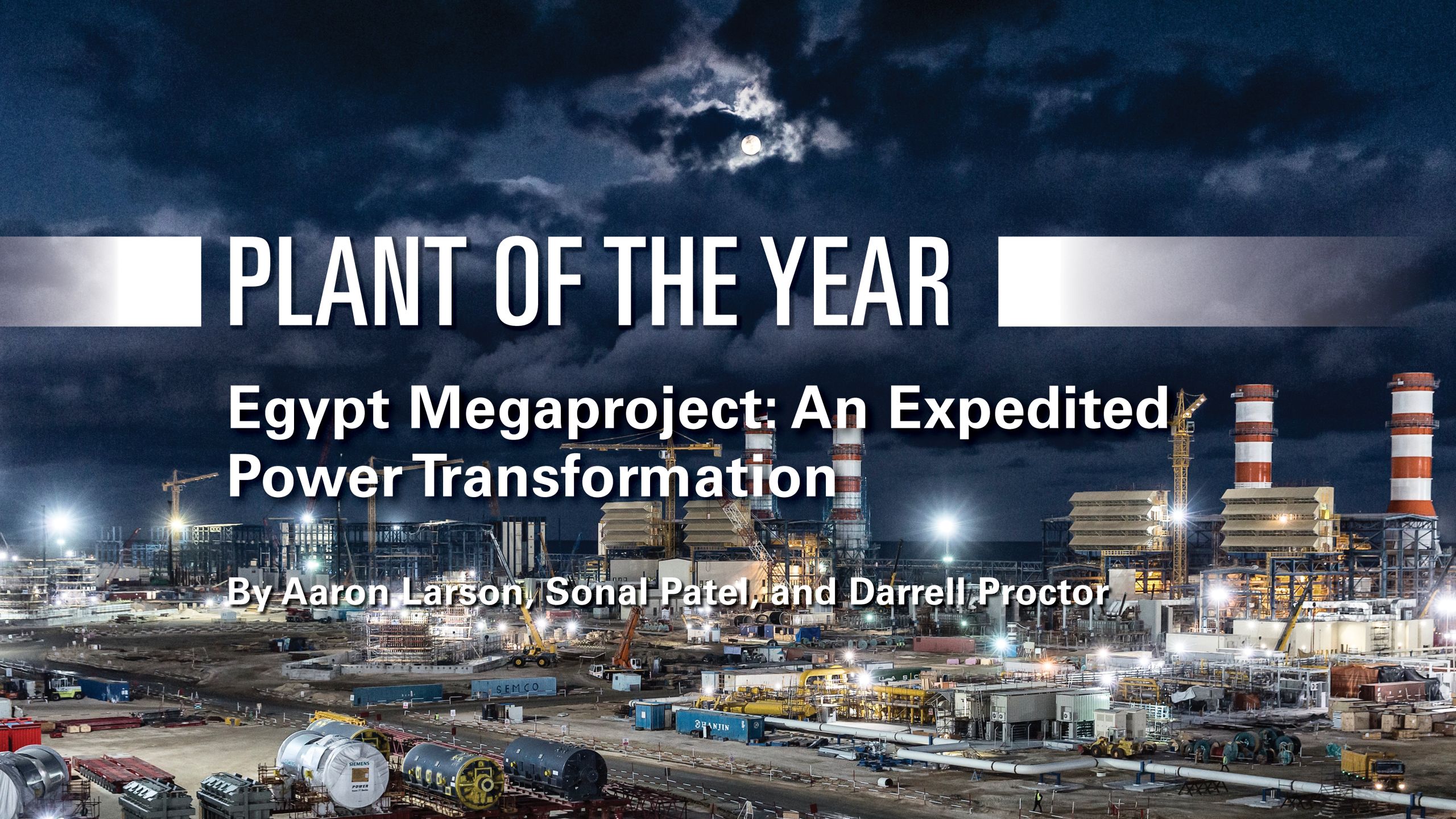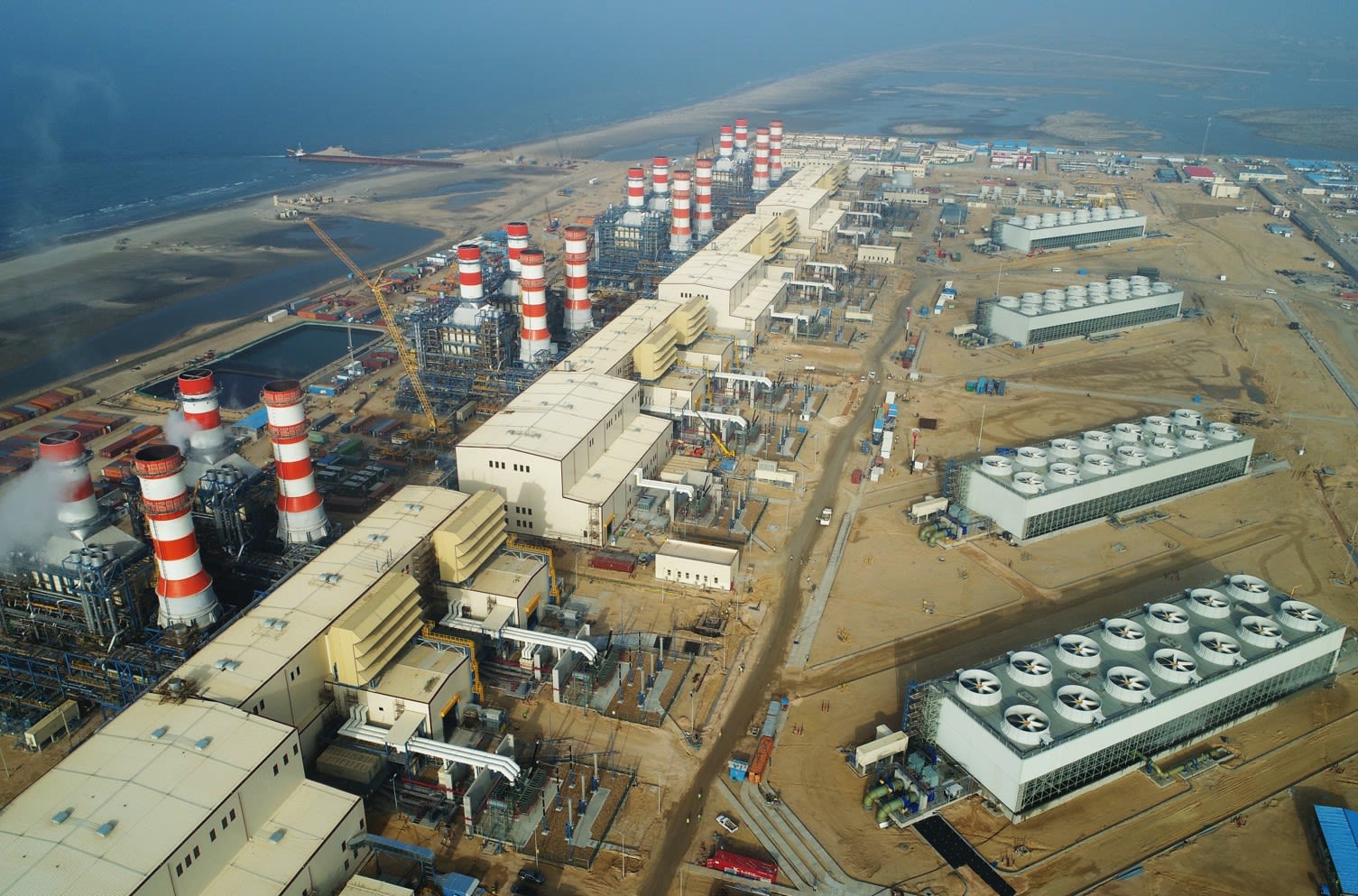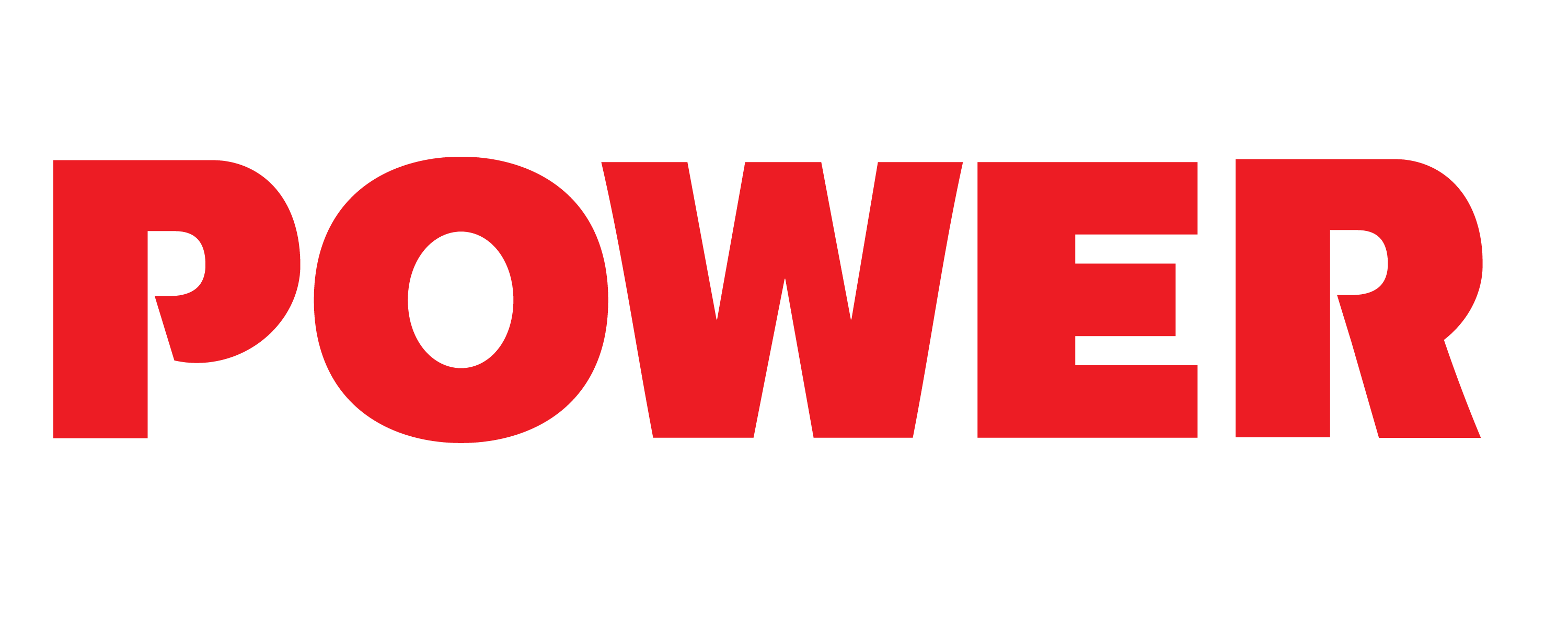
Winning POWER’s highest honor is a set of three gas-fired power plants and related infrastructure — the Egypt Megaproject — which was the single biggest order ever in Siemens’ long history. Completed in a record-setting 27.5 months from financial closure, the three plants added 14.4 GW to Egypt’s power grid, heaving the country away from persistent power shortages that would have crippled industrial growth and setting it firmly en route to long-term power security.

Like many countries in the Middle East and Africa, Egypt’s power supply has been somewhat unreliable over the years, with scattered unplanned outages due to increased demand from its growing population. Although Egypt is a large producer of oil and gas, the sector along with the rest of the nation’s economy suffered from an energy crisis after the country’s revolution in 2011.
Frequent blackouts in Egypt lessened investment interest from other countries. Government officials knew they needed to incentivize foreign investment to grow oil and gas production, a first step to restore the nation’s economy, and they needed strong international partners to help finance and build new power generation infrastructure.
During Egypt’s Economic Development Conference in March 2015, Siemens and the Egyptian government reached firm agreements to support the country in its mission to develop a reliable and sustainable power supply. In June that year, Siemens and its consortium partners signed contracts worth €6 billion for high-efficiency natural gas-fired power plants designed to boost Egypt’s power generation capacity by more than 40% compared to the country’s installed base in 2015.

Together with Elsewedy Electric and Orascom Construction, Siemens was invited to design, supply, and deliver three combined cycle power plants in Beni Suef (to service Upper Egypt), New Capital (to energize the new administrative center east of Cairo and the strategic area at New Suez Canal Development Zone), and Burullus (to supply the Nile Delta and the Mediterranean coast). Siemens’ Financial Services structured the financing package for Siemens’ role in the contracts, including a tailored guarantee concept. The envisaged loan facilities—supported to a large extent by coverage from two export credit agencies in Germany and Italy—were provided by international and regional banks.

While Siemens was tasked with the engineering, supplying, and delivering of the Egyptian Megaproject on a turnkey basis, many other companies and government partners would also play key roles. Siemens formed consortiums with Elsewedy Electric for the Beni Suef plant and with Orascom Construction for the Burullus and New Capital plants. Both Egyptian-based partners would perform admirably in bringing the projects to completion in record-setting time of 27.5 months from financial closure.

Leveraging Industry Expertise
Crucial to their selection for the Megaproject was that both Elsewedy and Orascom had garnered the necessary expertise and experience to complete a task of this magnitude and urgency.
When Egypt adopted its Fast Track Power Plan in December 2014 urging grid-connection of 3,632 MW before the end of 2015 to avoid debilitating power shortages, Cairo-based multinational conglomerate Elsewedy sprang to action, erecting the first project of the program—the 640-MW Attaqa Power Plant in Suez City—in a record-breaking 159 days to help ease the summer demand surge. (Attaqa was a POWER Top Plant in 2016).
Global engineering and construction contractor Orascom had also already been heavily involved in helping Egypt achieve its ambitions to nearly double its capacity over a sparse five-year timeframe. Among Orascom’s notable fast-track projects are two simple cycle power plants in Assiut and West Damietta (a total of 1,500 MW), which it delivered in under eight months in 2015 (and which it has since converted to combined cycle to boost their total capacity to 2,250 MW). Since 2015, Orascom has added more than 12 GW to the national grid as an engineering, procurement, and construction contractor.
Yet, Elsewedy Electric Group Legal Director Mahmoud Sharaawy described his company’s €820 million share of the project—putting up the 12 turbines at Beni Suef—as a massive undertaking that required deliberate and precise organization. One aspect that helped speed along the project was clarity about expectations, said Sharaawy. Elsewedy’s scope of work included engineering, procurement, site preparation, leveling, civil works, installation of balance-of-plant equipment, as well as installation of the Siemens turbines. The company spent two months negotiating agreements and technical parameters of each unit at the Beni Suef site with Siemens and Egypt, talks which culminated in a final agreement in June 2015 and set the stunning two-year timeframe.
“We finalized everything in less than three years,” Sharaawy pointed out, adding, “Supposedly, these types of plants take four to five years.” At Beni Suef, 6,000 workers toiled day and night to meet the tight schedule, amassing a stunning 22 million hours. “Those were safe working hours,” he stressed.
Orascom, too, wielded its vast expertise to get New Capital and Burullus built on time, and it echoed Elsewedy’s focus on safety. “We achieved over 90 million man-hours on the Burullus and New Capital Power Plants combined,” the company told POWER. Key to project completion was a “proactive and strong team that was able to look ahead and forecast any issues that could arise, resulting in an efficient risk-management approach,” it said.


Mega Equipment
Each of the three sites consists of four blocks. Each block has two Siemens SGT5-8000 H-class gas turbines (Figure 1), one steam turbine (Figure 2), three generators, two heat recovery steam generators (HRSGs), three transformers (Figure 3), and associated auxiliary equipment. Each site exports power—up to 4.8 GW—to the grid through a 500-kV gas-insulated switchgear.
Siemens’ H-class gas turbine operates at more than 61% efficiency in combined cycle mode. The high efficiency translates into significant fuel savings and reduced emissions compared to many other units available on the market. The Egyptian plants mainly rely on natural gas as their fuel sources, but one module at each facility is dual-fuel capable, with fuel oil used as a backup energy source.
The equipment was sourced from various manufacturing facilities around the world. The gas turbines came from Siemens’ Berlin, Germany, factory, while the steam turbines originated at the company’s plant in Mülheim, Germany. Some of the generators were sourced from Mülheim, while others shipped from Siemens’ Charlotte Energy Hub in North Carolina.
NEM Energy B.V.—a Siemens company—supplied the vertical, triple-pressure reheat, once-through HRSGs for the Megaproject from its South Korea manufacturing plant. The relatively light-weight HRSG design allows fast and flexible startups, with a small footprint. Each boiler contains 24 modules and approximately 14,000 single tubes, each around 20 meters in length.

1. A total of 24 Siemens SGT5-8000 H-class gas turbines were supplied for the Egyptian Megaproject. This image shows one of the gas turbines being placed into position at the Beni Suef site. Courtesy: Siemens
1. A total of 24 Siemens SGT5-8000 H-class gas turbines were supplied for the Egyptian Megaproject. This image shows one of the gas turbines being placed into position at the Beni Suef site. Courtesy: Siemens

2. In addition to gas turbines, the combined cycle power plant design used on the Egyptian Megaproject includes one steam turbine for each block. In this image, a low-pressure steam turbine rotor is being placed in its casing at the Beni Suef site. Courtesy: Siemens
2. In addition to gas turbines, the combined cycle power plant design used on the Egyptian Megaproject includes one steam turbine for each block. In this image, a low-pressure steam turbine rotor is being placed in its casing at the Beni Suef site. Courtesy: Siemens

3. As part of the Egyptian Megaproject, Siemens supplied transformers not only for the three power plants, but also for six substations. Courtesy: Siemens
3. As part of the Egyptian Megaproject, Siemens supplied transformers not only for the three power plants, but also for six substations. Courtesy: Siemens
Challenging Terrain
Although the three plants are designed similarly, certain aspects were affected by local factors. Beni Suef is located on the west bank of the Nile River in Upper Egypt, about 110 kilometers (km) from Cairo. New Capital is located about 45 km east of Greater Cairo near a new city that Egypt is building from scratch to ease congestion and overcrowding in Cairo. The city will ultimately house a new presidential palace, a new parliament building, a central bank, business district, and airport. Burullus, meanwhile, is situated about 200 km north of Cairo.
Because Beni Suef is located on the Nile River and Burullus is on the Mediterranean Sea, water for cooling purposes was not a major concern at those plants. However, the New Capital facility is located in the desert where water is scarce. Therefore, an air-cooled condenser—the largest of its kind in the world—was incorporated into that plant.
The topography of the Beni Suef site posed some unique challenges. The plant was built on a hilltop, which required the excavation of about 1.75 million cubic meters of hard rock over five months. “You can imagine it as equivalent to the size of a small Egyptian pyramid,” Dalia Abou El Seoud, Siemens’ deputy director for the Megaproject, told POWER. “It’s huge!” To account for the 40-meter slope from the Nile to the highest level, the site was terraced, with the plant placed at the top and the water treatment plant nearer to the river. “It’s actually a very panoramic and picturesque power plant,” she said. At Beni Suef, Elsewedy also spent four months backfilling; four more months reinforcing concrete; five months completing the steel structures; and three months installing open-cycle piping.
Burullus also faced extreme challenges, owing to difficult site conditions. The project is located near Lake Burullus, a brackish-water lake in the Nile Delta, a remote site that required “additional complex geotechnical engineering with significantly greater soil improvement and piling work than expected,” Orascom said. Orascom also chose to run the plant’s cooling pipelines below ground and under the sea, which required building an “immense” marine and water intake structure in the open sea. Developers opted for the design aspect over easier alternatives because it was integral to shoreline preservation.
Mega Logistics
The heavy-cargo shuttle was used to move the gas turbines via waterways through parts of Berlin to Westhafen—the city’s western harbor. At Berlin-Westhafen, the equipment was hoisted from the cargo shuttles onto barges for transport to either Rotterdam, Netherlands, or Hamburg, Germany. Once there, the gas turbines were loaded onto heavy-load carrier ships using onboard cranes.
The ships traveled to the Mediterranean Sea across the Strait of Gibraltar. The cargo passed through the Suez Canal and arrived at the destination port of Adabiya on the Red Sea. A 40-axle trailer then transported the turbines the rest of the way, traveling the 250-km route along the Nile to Beni Suef in about five days.
“We had some great support from the government as this was a national project, which facilitated lots of logistics challenges,” said Abou El Seoud. “However, it was not an easy job because we had to coordinate to get the different equipment from all over the world.”
Transporting equipment to other sites was similarly difficult. In fact, the Burullus site offered additional challenges. “Burullus is hard to reach—so we had to build a fishing port in Burullus in order to accommodate big vessels and to get the big machines inside the country without having to build up new roads,” Abou El Seoud said.

4. Moving H-class gas turbines, which weigh 445 tons, is no small task. The special 192-wheel vehicle shown here was used for one portion of the journey from the factory in Berlin, Germany, to each plant site in Egypt. Cranes, ships, and other heavy-cargo shuttles were also used along the way. Courtesy: Siemens
4. Moving H-class gas turbines, which weigh 445 tons, is no small task. The special 192-wheel vehicle shown here was used for one portion of the journey from the factory in Berlin, Germany, to each plant site in Egypt. Cranes, ships, and other heavy-cargo shuttles were also used along the way. Courtesy: Siemens

5. Cranes, ships, and other heavy-cargo shuttles were also used along the way from the factory in Berlin, Germany, to each plant site in Egypt. Courtesy: Siemens
5. Cranes, ships, and other heavy-cargo shuttles were also used along the way from the factory in Berlin, Germany, to each plant site in Egypt. Courtesy: Siemens
Recruiting and Training
A main focus of the Egyptian Megaproject was not only bridging the country’s energy gap, but also contributing to the Egyptian society by educating people and preparing them for sophisticated, high-level technical jobs.
Construction projects are quite common in Egypt, so a fairly large pool of qualified construction workers was available to draw from. However, more than 24,000 workers would eventually be needed at the three sites during the peak of construction, so getting ramped up was no small task.
At Elsewedy and Orascom, sourcing manpower and talent was fairly routine, owing to the companies’ separate work pools from other Egyptian projects. “We used mainly subcontractors in addition to our human resources team, and people living in Beni Suef,” said Sharaawy. Both companies noted that work culture is also founded on safety protocols and procedures.
Nonetheless, the industrial safety culture in Egypt was different from what Siemens was used to in other countries. “Safety was always an integral part of whatever measures that we do on the ground,” Ahmed El Saadany, head of Siemens Professional Education for the Middle East and Africa region, told POWER. So, the company added a step to enhance safety performance and ensure it met expectations.
“We had built up for each of the power plants a full training center including simulators on different safety hazard situations and use of personal protective equipment,” El Saadany said. Siemens then made completion of training at the centers a prerequisite for site entry. That went a long way toward bridging the gap in Egyptian and German safety culture.
“There was always this commitment not only to build the power plants, but also to train the Egyptian people,” El Saadany said. The goal was to staff the power plants with Egyptian citizens, and that meant educating workers to meet Siemens’ high standards.
In the beginning, the task of staffing the power plants sounded easy enough. Egypt has a population of about 100 million people and more than half are under the age of 30. That meant there was a youthful, energetic core of reasonably tech-savvy recruits waiting to be tapped. However, finding people who could meet Siemens’ hiring criteria proved to be much more difficult than finding construction workers.

The company targeted 200 operations and maintenance personnel for each facility, making a total of 600 recruits needed. Like most hiring processes, reviewing applications and interviewing candidates took time, and many more applicants were rejected than accepted, but the mission was ultimately accomplished.
“In order to enable those young Egyptians to enhance their professional and vocational competencies, while building local experts in the energy industry over the next years, Siemens has made significant investments to further develop their learning and training capabilities to create a positive long-term ripple effect on Egypt’s society as those who have received the training will pass on their skills to the next generation,” El Saadany said.
All 600 completed a six-month training program, divided between Egypt and Germany. Furthermore, they came back to jobsites for hands-on training during the construction. As Siemens was also awarded an eight-year contract for the operation and maintenance of the three power plants, the operations and maintenance personnel were hired for the same period, sustainably contributing to the country’s growth, El Saadany said.
But the story doesn’t end there. Siemens worked with Germany’s Federal Ministry for Economic Cooperation and Development to broaden societal opportunities by establishing the Egyptian German Technical Academy in Ain Sokhna, Egypt, not far from the New Capital plant. The initial goal is to train 5,500 Egyptian youth over the next four years.
Siemens’ aim in creating the academy was to ensure future generations would get the same level of quality education the 600 new-hires received without having to leave the country. The technical training that was conducted in Germany can now be done in Egypt, and the facility will serve as an educational resource for the entire region and even other industries.
Siemens also helped create “a meaningful pathway for technical and vocational education and training in Egypt” by helping modernize two facilities in the local education system. The Zein Al Abedeen School of Excellence, a “technical secondary school,” now offers a three-year basic technical education program that prepares students for a two-year program at the Higher Technical Institute, located in the El Ameriya area of Cairo. Successful graduates may eventually take industry-specific gap-filler courses at the academy in Ain Sokhna.
“That was, let’s say, the offspring from this Megaproject and power plants,” El Saadany said.

Project Management Takeaways
Managing any Megaproject is difficult, but when a very tight project execution schedule is incorporated, it places even more stress on the management team. “Quite many colleagues were questioning whether we at Siemens as an organization would be able to execute according to the schedule and also to budget,” Laurenz Krause, Siemens’ director of projects for the Egypt Megaproject, said in an interview in June with POWER. “To streamline the process, we received great direct support from the highest management level including Joe Kaeser [CEO of Siemens AG], who made a promise to the Egyptian president that the Egyptian people can count on Siemens to achieve this mission-critical project,” Krause said.
According to Krause, the highest attention was given to the avoidance of any delay and to create float in the schedule. “This you can only achieve together with your extremely committed team taking ownership for all their tasks during project phases, which included the engineering, construction, and commissioning period,” he said.
“In addition to all this, we had outstanding collaboration and trust with our consortium partners like I have never experienced before. We also received genuine support from all Egyptian stakeholders, and I would say that all this beautiful and diverse mix has contributed to the entire Megaproject’s success in a record-breaking time of less than 3 years,” Krause concluded.
For Elsewedy’s part, Sharaawy credited the company’s skilled professional management team, which accrued valuable experience over varied projects (the company connected 1,500 MW of conventional and renewable projects across Egypt, Iraq, and Jordan last year alone). “We have good experience and [the know-how] to expedite projects with excellent quality. We can say that we have a ‘dream team’ of finalizing these kinds of projects,” he said. “Along with the experience, we had skilled people, we had the empowerment of the government, and those are key factors that collected to finalize the project in this way.”
Orascom, too, pointed to experience, proactivity, and preventative measures for its success, stressing these attributes were crucial in forestalling delays that, for example, typically affect equipment procurement. “We leveraged our execution experience particularly as a contractor and our ability to raise financing efficiently, which is something that we have done in other industries such as cement and fertilizer,” the company noted.

6. Thousands of kilometers of power lines and new electrical infrastructure have been added to the Egyptian power grid since 2014, including the Burullus transmission lines shown here. Courtesy: Siemens
6. Thousands of kilometers of power lines and new electrical infrastructure have been added to the Egyptian power grid since 2014, including the Burullus transmission lines shown here. Courtesy: Siemens
A Power Reinvention
Perhaps the biggest beneficiaries of the Megaproject are Egyptians themselves. Egypt is the most populous country in North Africa and the Arab region, and home to one of the fastest-growing populations globally. But only 10 years ago, it suffered a chronic power shortage of between 20% and 25% that resulted in blackouts and power outages, especially during hot summer months, affecting residential and industrial areas alike. Freshly emerging from the political and economic shakeup stemming from the 2011 revolution, the government prioritized efforts to bridge the chasm between power demand and supply, and sought to address a growing natural gas supply crisis.
Along with urgent measures to scale up infrastructure spending to alleviate the crippling electricity crisis, reforms sought to liberalize energy prices and completely eliminate subsidies by 2022 in a bid to pave the way for private companies to engage in power generation, which had previously been dominated by state entities. The government also rolled out a new energy strategy, setting ambitious targets to boost its generating capacity to add 54 GW to its 2015 total installed capacity of 31.34 GW by 2022—and it’s already halfway there. While the 2014 Fast Track Program added 3.6 GW by 2016, Egypt had grid-connected an additional 5.6 GW of new capacity and another 1.8 GW from combined cycle conversion projects outside of the fast-track program. Meanwhile, since 2014, 5,546 km of new lines to bolster the 500-kV transmission network have been added to the grid (Figure 6).
The three Siemens Megaproject power plants add another 14.4 GW, bringing total capacity added since 2014 to 25.4 GW. It means, as the head of the Administrative Control Authority, Mohamed Erfan, said during a July 2018 inauguration ceremony for the three plants, that Egypt went from chronic deficit to a 25% capacity surplus in just four years. And now it is poised to begin exporting power. Among its potential power-hungry neighbors are Sudan, Cyprus, Syria, and Jordan. For transforming a nation’s power security trajectory from scarcity to abundance, and doing it so quickly, the Megaproject deserves the recognition that this award, POWER’s highest honor, can confer.
— Aaron Larson is POWER’s executive editor; Sonal Patel and Darrell Proctor are POWER associate editors.

